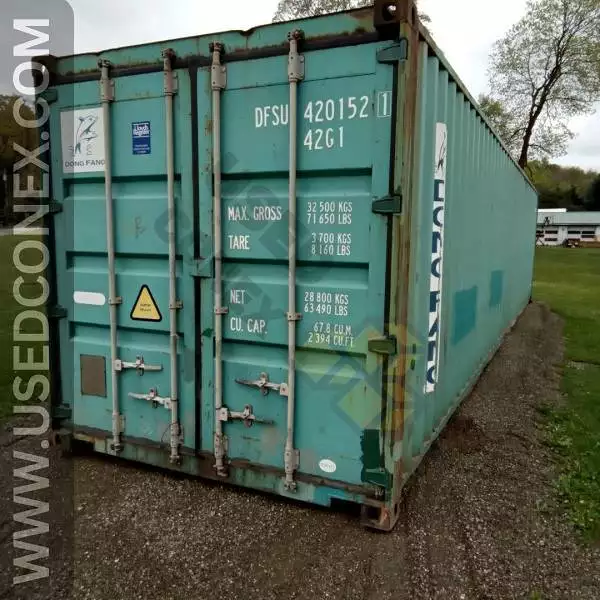
What is Shipping Container Depreciation?
What is Shipping Container Depreciation?
The transportation of goods over long distances is made possible by shipping containers which are widely used in global trade. Despite their resilience and durability of these containers eventually lose value just like any other asset because of depreciation. This article will delve into the importance of understanding shipping container depreciation its causes and contributing factors.
Thank you for reading this post, don't forget to subscribe!Defining the Depreciation
The decline in the value of shipping containers over a period is known as depreciation. This reduction in worth is because of factors such as usage, wear and tear, obsolescence or shifts in market demand. The notion of asset devaluation is widespread among accounting and finance practitioners.
When it comes to shipping containers, there are multiple reasons they lose value over time. This is due to factors like wear and tear, technological advancements, and market changes. These variables all play a role in reducing the container’s monetary worth and overall practicality.
Shipping containers are constructed to endure the challenges of shipping, storage and handling; nevertheless, they remain vulnerable to physical damage. When exposed to environmental factors such as moisture salt or temperature fluctuations these containers can suffer from corrosion, rusting or dents which may affect their appearance and structural stability while also reducing their lifespan. This decrease in durability ultimately leads to a decline in value for the container.
Technological progress can influence container devaluation. Introducing fresh container styles and substances may make older containers less appealing or efficient. For instance, shipping companies and consumers may prefer newer containers because of advancements in structural strength, insulation, or environmental sustainability. Therefore, outdated design or functionality can cause the value of older containers to decline.
In addition, container depreciation is influenced by market forces and imbalances in the supply and demand. When there are more containers available than needed, their worth may decrease because of reduced market interest. Likewise, alterations in trade patterns or shipping routes and industry participants’ preferences for certain types of containers can also affect how quickly they depreciate.
Businesses typically calculate and record the devaluation of shipping containers in their financial records over a specific period called their useful lifespan. This predetermined timeframe indicates how long the container can stay functional and generate profit. Factors like quality, industry upkeep standards, and specific company needs can affect estimates of a container’s useful lifespan.
Comprehending the decrease in value of shipping containers is essential for individuals or entities who possess them rent them out, and those involved in the shipment industry. It enables these parties to wisely decide on financial matters prepare for expenses related to upkeep and renewal and enhance their container possessions’ worth as time goes by. Through efficient handling of depreciation rates, stakeholders can prevent monetary setbacks and guarantee optimal use of their shipping containers.
Factors Influencing Depreciation
Knowing the key elements that impact shipping container depreciation is crucial for industry stakeholders and owners and shipping companies. This understanding can aid in effective asset management and informed financial decision-making. The following are some factors that influence container depreciation:
Physical Wear and Tear
-
- Environmental Conditions: Shipping containers are exposed to various environmental elements during transportation and storage, such as moisture, saltwater, extreme temperatures and humidity. These conditions can cause corrosion, rust and other forms of physical deterioration.
- Handling and Transportation: Containers undergo multiple loading, unloading, stacking and transportation cycles. The constant handling and movement can result in dents, scratches and structural damage impacting their overall condition and value.
Technological Advancements
- Container Design Improvements: The shipping industry continually evolves with new container designs offering enhanced features, such as improved structural strength, insulation, or energy efficiency. Older containers may become less desirable or less efficient in comparison leading to depreciation in value.
- Material Innovations: Advancements in container materials, such as high strength steel alloys or composite materials, can impact the value of older containers that use traditional materials. New materials may offer improved durability, weight reduction or resistance to corrosion making older containers less competitive.
- Industry Standards and Regulations: Changes in safety regulations, environmental requirements or industry standards may render older containers non-compliant or less attractive to shipping companies resulting in depreciation.
Market Supply and Demand
- Oversupply: An imbalance between the supply and demand of shipping containers can lead to a decrease in their value. When the market is oversupplied with containers, prices tend to drop due to increased competition among owners and leasing companies.
- Fluctuations in Demand: Changes in global trade patterns, economic conditions or shifts in consumer demand can influence the demand for shipping containers. A decline in demand for containerized goods or shifts in trade routes can reduce container value and usage, leading to depreciation.
- Regional Disparities: Container availability and demand can vary across different regions and ports. In regions with high demand and limited supply, containers often depreciate more slowly than in areas with low demand and surplus inventory.
Depreciation rates for shipping containers vary based on quality, maintenance practices, and market conditions. Regular upkeep, timely repairs, and proactive monitoring can reduce depreciation while enhancing the containers‘ lifespan and value.



